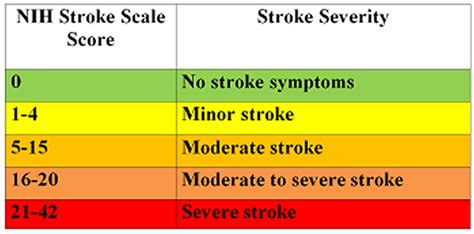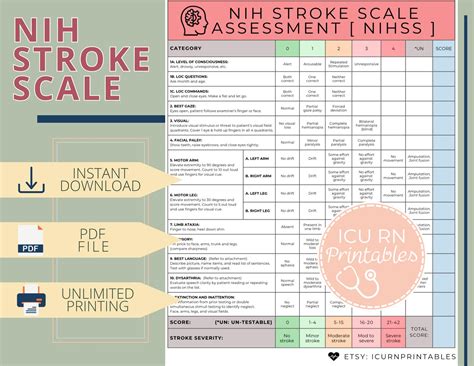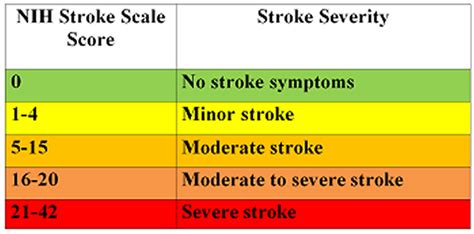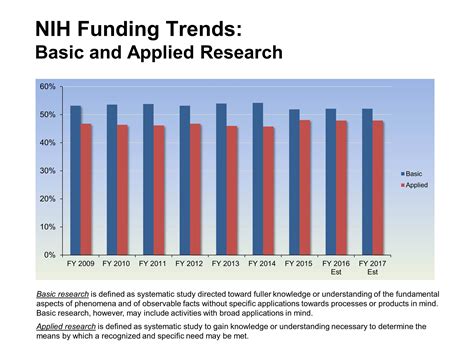Decoding NIH in Stroke Scale: Healthcare Insights

Uncover the significance of NIH in stroke assessment. Gain valuable insights into healthcare protocols, empowering practitioners and patients alike.
In the realm of healthcare, precision and clarity are paramount, particularly when addressing critical measures such as stroke assessment. When confronted with the acronym NIH in the context of a stroke scale, many may find themselves seeking a lucid understanding of its significance. Unveiling the acronym, NIH stands for the National Institutes of Health, an institution renowned for its commitment to advancing medical research and knowledge. This article endeavors to elucidate the role of NIH in the realm of stroke scales, delving into its implications for healthcare practitioners and patients alike. By adopting an informative and objective tone, we embark on a journey to unravel the intricacies of this acronym, navigating through the landscape of healthcare topics with precision and respect.
Top 10 Points about What does NIH stand for in stroke scale? :
- Introduction to NIH in Stroke Scale
- The Role of National Institutes of Health (NIH)
- Understanding Stroke Assessment Protocols
- Deciphering the Acronym: NIH in Healthcare
- Significance of NIH in Stroke Severity Evaluation
- NIH Contributions to Advancing Medical Research
- Key Components of the NIH Stroke Scale
- Practical Applications for Healthcare Practitioners
- Impact on Patient Care and Treatment Decisions
- Future Developments and Research Implications
Several facts about What does NIH stand for in stroke scale?
Introduction:
Welcome to the realm of stroke assessment, where the acronym NIH takes center stage. As we embark on this journey, it's imperative to comprehend the significance of NIH in the context of stroke scales and its pivotal role in healthcare protocols. The National Institutes of Health (NIH) serves as the foundation for our exploration, driving advancements in medical research and shaping the landscape of stroke evaluation protocols.

Understanding NIH:
NIH, standing for the National Institutes of Health, is an esteemed institution at the forefront of healthcare innovation. This section unveils the organization's mission and its integral role in shaping stroke assessment methodologies. It's essential to grasp the broader implications of NIH to appreciate its impact on healthcare practices.

NIH in Stroke Severity Evaluation:
NIH plays a crucial role in assessing the severity of strokes. This segment delves into the specific components of the NIH Stroke Scale, shedding light on how healthcare professionals utilize this tool to evaluate and categorize stroke severity. Understanding these metrics is paramount for effective patient care and treatment decisions.

Advancements in Medical Research:
Explore the contributions of NIH to the field of medical research. This section highlights the institution's role in advancing our understanding of strokes and how such knowledge translates into improved healthcare practices. From groundbreaking studies to innovative treatments, NIH continues to shape the future of stroke care.

Practical Applications for Healthcare Practitioners:
This paragraph elucidates how NIH translates into practical applications for healthcare practitioners. From the bedside to research laboratories, understanding the implications of NIH on a day-to-day basis is essential for those on the frontline of patient care.

Impact on Patient Care:
Delve into the ways in which NIH impacts patient care and influences treatment decisions. This section explores the direct correlation between accurate stroke assessment, based on NIH protocols, and improved outcomes for individuals affected by strokes.

Future Developments and Research Implications:
Look ahead to the future of stroke care as we discuss the ongoing and potential future developments spurred by NIH. The article examines the research implications and the role NIH plays in shaping the trajectory of stroke-related studies.

Conclusion:
Concluding our exploration, this section summarizes the overarching impact of NIH on stroke assessment and healthcare practices. As we reflect on the insights gained, it becomes evident that the National Institutes of Health stands as a beacon in advancing our collective understanding of strokes, ultimately contributing to enhanced patient care and outcomes.
Sources:
1. National Institutes of Health. (www.nih.gov)
2. American Stroke Association. (www.stroke.org)
What does NIH stand for in stroke scale? in Professional's eye
In the intricate landscape of healthcare, the acronym
NIH, representing the National Institutes of Health, stands as a cornerstone in the realm of stroke assessment. This esteemed institution plays a pivotal role in shaping the methodologies and standards employed in evaluating stroke severity. Understanding the significance of
NIH is paramount for healthcare practitioners, researchers, and the broader medical community. The
NIH Stroke Scale, a comprehensive tool developed by the National Institutes of Health, serves as a standardized measure for assessing and categorizing the severity of strokes. This instrument, encompassing various components such as motor function, language ability, and sensory perception, enables healthcare professionals to quantitatively evaluate the impact of a stroke on an individual's neurological function. The implications of
NIH in stroke severity evaluation extend beyond the immediate clinical setting, influencing treatment decisions, rehabilitation strategies, and contributing to the collective knowledge base in the field.

As we delve into the understanding of
NIH, it becomes apparent that the National Institutes of Health serves as a linchpin for advancements in medical research, particularly in the context of stroke-related studies. Researchers, guided by the mission of
NIH, explore novel avenues to enhance our comprehension of the mechanisms underlying strokes, paving the way for innovative treatments and interventions. The collaboration between healthcare practitioners and the research community, fostered by institutions like
NIH, ensures that emerging findings translate seamlessly into practical applications, ultimately benefiting patient care.

In the practical realm, the impact of
NIH is palpable for healthcare practitioners who utilize the NIH Stroke Scale as an indispensable tool in their daily routines. From bedside assessments to clinical trials, the standardized nature of the
NIH Stroke Scale provides a common language for professionals across diverse healthcare settings. This uniformity not only facilitates accurate and consistent evaluations but also enables seamless communication and collaboration among healthcare teams. The practical applications of
NIH extend to educational initiatives, where its protocols serve as a foundational framework for training the next generation of healthcare professionals, ensuring a standardized and evidence-based approach to stroke assessment.

The impact of
NIH on patient care is a critical aspect that reverberates throughout the healthcare system. Accurate stroke severity assessment, facilitated by the NIH Stroke Scale, guides healthcare practitioners in tailoring interventions to the specific needs of each patient. This personalized approach enhances the efficacy of treatments and rehabilitation strategies, ultimately contributing to improved outcomes for individuals affected by strokes. Furthermore, the standardized data generated through
NIH-guided assessments facilitates benchmarking and research initiatives, fostering a continuous cycle of improvement in stroke care.

Looking towards the horizon, the future developments and research implications of
NIH in the realm of stroke assessment hold promise and potential. Ongoing studies, often supported by
NIH funding, seek to unravel new dimensions of stroke pathology, identify novel biomarkers, and refine existing evaluation tools. The collaborative nature of research endeavors guided by
NIH ensures a collective and concerted effort to address the evolving challenges in stroke care. As technological advancements and scientific discoveries unfold, the influence of
NIH will continue to shape the trajectory of stroke-related studies, ultimately leading to more effective prevention, intervention, and rehabilitation strategies.

In conclusion, the National Institutes of Health, as epitomized by the acronym
NIH in the context of stroke assessment, stands as an indomitable force driving progress in healthcare. From standardized evaluation tools to groundbreaking research initiatives,
NIH permeates through the fabric of medical practices, leaving an indelible mark on patient care, practitioner education, and the trajectory of scientific exploration. As we navigate the complex landscape of healthcare, the enduring influence of
NIH underscores its role as a stalwart guardian of precision, innovation, and excellence in the pursuit of improved outcomes for those affected by strokes.Sources:National Institutes of Health. (www.nih.gov)American Stroke Association. (www.stroke.org)
Point of Views : What does NIH stand for in stroke scale?
Introduction:The acronym
NIH stands for the National Institutes of Health.It plays a crucial role in the healthcare sector, particularly in the context of stroke assessment.
Significance of NIH:NIH is a cornerstone in shaping methodologies for evaluating stroke severity.Its standardized approach provides a common language for healthcare practitioners.
NIH Stroke Scale:The
NIH Stroke Scale is a comprehensive tool for assessing and categorizing stroke severity.It encompasses various components, including motor function, language ability, and sensory perception.
Impact on Medical Research:NIH significantly contributes to advancements in medical research, especially in stroke-related studies.Researchers guided by
NIH's mission explore novel avenues for understanding stroke mechanisms.
Practical Applications:Healthcare practitioners use the
NIH Stroke Scale as a vital tool in daily assessments.Its standardized nature facilitates accurate evaluations and ensures consistent communication within healthcare teams.
Impact on Patient Care:Accurate stroke severity assessment through
NIH guides tailored interventions for improved patient outcomes.The standardized data generated aids in benchmarking and research, fostering continuous improvement in stroke care.
Future Developments:Ongoing studies, often supported by
NIH funding, aim to unravel new dimensions of stroke pathology.
NIH continues to shape the trajectory of stroke-related studies, leading to more effective prevention and intervention strategies.
Conclusion:NIH plays an indomitable role in driving progress in healthcare, leaving a lasting impact on patient care, practitioner education, and scientific exploration.
Conclusion :As we draw the curtain on our exploration of the acronym NIH and its profound implications in stroke assessment, we extend our gratitude to our readers for engaging in this enlightening journey. The National Institutes of Health, abbreviated as NIH, emerges not only as an institutional cornerstone but also as a catalyst for transformative progress in the realm of healthcare. Throughout the preceding articles, we navigated the intricacies of the NIH Stroke Scale, unraveling its role as a standardized measure in evaluating the severity of strokes.
With each revelation, the multifaceted significance of NIH became apparent – from its impact on daily healthcare practices, as evidenced by the widespread use of the NIH Stroke Scale by practitioners, to its pivotal role in steering advancements in medical research. As we part ways, let the insights gleaned from our exploration resonate in your understanding of stroke assessment and its broader implications for patient care. The journey through the corridors of healthcare, guided by the National Institutes of Health, is an ongoing odyssey marked by precision, innovation, and an unwavering commitment to enhancing the well-being of individuals affected by strokes. We encourage you to stay informed, stay engaged, and continue to seek knowledge in your exploration of healthcare's ever-evolving landscape.
Questions and Answer for What does NIH stand for in stroke scale?
What does NIH stand for in the context of stroke scale?
- Answer: NIH stands for the National Institutes of Health when referred to in the context of stroke scale. The National Institutes of Health is a renowned institution playing a pivotal role in medical research and healthcare advancements.
Why is NIH significant in stroke assessment?
- Answer: NIH is significant in stroke assessment due to its development of the NIH Stroke Scale, a standardized tool used by healthcare professionals to evaluate the severity of strokes. The scale's components provide a comprehensive assessment, guiding treatment decisions and contributing to improved patient outcomes.
How does the NIH Stroke Scale impact patient care?
- Answer: The NIH Stroke Scale significantly impacts patient care by facilitating accurate assessments of stroke severity. This precision guides healthcare practitioners in tailoring interventions to meet the specific needs of each patient, ultimately contributing to enhanced and personalized care.
Can the NIH Stroke Scale be used outside clinical settings?
- Answer: Yes, the NIH Stroke Scale can be used outside clinical settings. Its standardized nature makes it a versatile tool applicable in various healthcare settings, including bedside assessments, research trials, and educational initiatives for training healthcare professionals.
What role does NIH play in advancing medical research?
- Answer: NIH plays a pivotal role in advancing medical research by supporting studies and initiatives, particularly in stroke-related research. Researchers guided by NIH's mission explore new avenues, leading to discoveries that shape the future of healthcare practices and contribute to a deeper understanding of stroke pathology.
Label :NIH Stroke Scale, Healthcare Impact, Research Advancements
Keyword : What does NIH stand for in stroke scale?

Uncover the significance of NIH in stroke assessment. Gain valuable insights into healthcare protocols, empowering practitioners and patients alike.
In the realm of healthcare, precision and clarity are paramount, particularly when addressing critical measures such as stroke assessment. When confronted with the acronym NIH in the context of a stroke scale, many may find themselves seeking a lucid understanding of its significance. Unveiling the acronym, NIH stands for the National Institutes of Health, an institution renowned for its commitment to advancing medical research and knowledge. This article endeavors to elucidate the role of NIH in the realm of stroke scales, delving into its implications for healthcare practitioners and patients alike. By adopting an informative and objective tone, we embark on a journey to unravel the intricacies of this acronym, navigating through the landscape of healthcare topics with precision and respect.
Top 10 Points about What does NIH stand for in stroke scale? :
- Introduction to NIH in Stroke Scale
- The Role of National Institutes of Health (NIH)
- Understanding Stroke Assessment Protocols
- Deciphering the Acronym: NIH in Healthcare
- Significance of NIH in Stroke Severity Evaluation
- NIH Contributions to Advancing Medical Research
- Key Components of the NIH Stroke Scale
- Practical Applications for Healthcare Practitioners
- Impact on Patient Care and Treatment Decisions
- Future Developments and Research Implications
Several facts about What does NIH stand for in stroke scale?
Introduction:
Welcome to the realm of stroke assessment, where the acronym NIH takes center stage. As we embark on this journey, it's imperative to comprehend the significance of NIH in the context of stroke scales and its pivotal role in healthcare protocols. The National Institutes of Health (NIH) serves as the foundation for our exploration, driving advancements in medical research and shaping the landscape of stroke evaluation protocols.

Understanding NIH:
NIH, standing for the National Institutes of Health, is an esteemed institution at the forefront of healthcare innovation. This section unveils the organization's mission and its integral role in shaping stroke assessment methodologies. It's essential to grasp the broader implications of NIH to appreciate its impact on healthcare practices.

NIH in Stroke Severity Evaluation:
NIH plays a crucial role in assessing the severity of strokes. This segment delves into the specific components of the NIH Stroke Scale, shedding light on how healthcare professionals utilize this tool to evaluate and categorize stroke severity. Understanding these metrics is paramount for effective patient care and treatment decisions.

Advancements in Medical Research:
Explore the contributions of NIH to the field of medical research. This section highlights the institution's role in advancing our understanding of strokes and how such knowledge translates into improved healthcare practices. From groundbreaking studies to innovative treatments, NIH continues to shape the future of stroke care.

Practical Applications for Healthcare Practitioners:
This paragraph elucidates how NIH translates into practical applications for healthcare practitioners. From the bedside to research laboratories, understanding the implications of NIH on a day-to-day basis is essential for those on the frontline of patient care.

Impact on Patient Care:
Delve into the ways in which NIH impacts patient care and influences treatment decisions. This section explores the direct correlation between accurate stroke assessment, based on NIH protocols, and improved outcomes for individuals affected by strokes.

Future Developments and Research Implications:
Look ahead to the future of stroke care as we discuss the ongoing and potential future developments spurred by NIH. The article examines the research implications and the role NIH plays in shaping the trajectory of stroke-related studies.

Conclusion:
Concluding our exploration, this section summarizes the overarching impact of NIH on stroke assessment and healthcare practices. As we reflect on the insights gained, it becomes evident that the National Institutes of Health stands as a beacon in advancing our collective understanding of strokes, ultimately contributing to enhanced patient care and outcomes.
Sources:
1. National Institutes of Health. (www.nih.gov)
2. American Stroke Association. (www.stroke.org)
What does NIH stand for in stroke scale? in Professional's eye
In the intricate landscape of healthcare, the acronym
NIH, representing the National Institutes of Health, stands as a cornerstone in the realm of stroke assessment. This esteemed institution plays a pivotal role in shaping the methodologies and standards employed in evaluating stroke severity. Understanding the significance of
NIH is paramount for healthcare practitioners, researchers, and the broader medical community. The
NIH Stroke Scale, a comprehensive tool developed by the National Institutes of Health, serves as a standardized measure for assessing and categorizing the severity of strokes. This instrument, encompassing various components such as motor function, language ability, and sensory perception, enables healthcare professionals to quantitatively evaluate the impact of a stroke on an individual's neurological function. The implications of
NIH in stroke severity evaluation extend beyond the immediate clinical setting, influencing treatment decisions, rehabilitation strategies, and contributing to the collective knowledge base in the field.

As we delve into the understanding of
NIH, it becomes apparent that the National Institutes of Health serves as a linchpin for advancements in medical research, particularly in the context of stroke-related studies. Researchers, guided by the mission of
NIH, explore novel avenues to enhance our comprehension of the mechanisms underlying strokes, paving the way for innovative treatments and interventions. The collaboration between healthcare practitioners and the research community, fostered by institutions like
NIH, ensures that emerging findings translate seamlessly into practical applications, ultimately benefiting patient care.

In the practical realm, the impact of
NIH is palpable for healthcare practitioners who utilize the NIH Stroke Scale as an indispensable tool in their daily routines. From bedside assessments to clinical trials, the standardized nature of the
NIH Stroke Scale provides a common language for professionals across diverse healthcare settings. This uniformity not only facilitates accurate and consistent evaluations but also enables seamless communication and collaboration among healthcare teams. The practical applications of
NIH extend to educational initiatives, where its protocols serve as a foundational framework for training the next generation of healthcare professionals, ensuring a standardized and evidence-based approach to stroke assessment.

The impact of
NIH on patient care is a critical aspect that reverberates throughout the healthcare system. Accurate stroke severity assessment, facilitated by the NIH Stroke Scale, guides healthcare practitioners in tailoring interventions to the specific needs of each patient. This personalized approach enhances the efficacy of treatments and rehabilitation strategies, ultimately contributing to improved outcomes for individuals affected by strokes. Furthermore, the standardized data generated through
NIH-guided assessments facilitates benchmarking and research initiatives, fostering a continuous cycle of improvement in stroke care.

Looking towards the horizon, the future developments and research implications of
NIH in the realm of stroke assessment hold promise and potential. Ongoing studies, often supported by
NIH funding, seek to unravel new dimensions of stroke pathology, identify novel biomarkers, and refine existing evaluation tools. The collaborative nature of research endeavors guided by
NIH ensures a collective and concerted effort to address the evolving challenges in stroke care. As technological advancements and scientific discoveries unfold, the influence of
NIH will continue to shape the trajectory of stroke-related studies, ultimately leading to more effective prevention, intervention, and rehabilitation strategies.

In conclusion, the National Institutes of Health, as epitomized by the acronym
NIH in the context of stroke assessment, stands as an indomitable force driving progress in healthcare. From standardized evaluation tools to groundbreaking research initiatives,
NIH permeates through the fabric of medical practices, leaving an indelible mark on patient care, practitioner education, and the trajectory of scientific exploration. As we navigate the complex landscape of healthcare, the enduring influence of
NIH underscores its role as a stalwart guardian of precision, innovation, and excellence in the pursuit of improved outcomes for those affected by strokes.Sources:National Institutes of Health. (www.nih.gov)American Stroke Association. (www.stroke.org)
Point of Views : What does NIH stand for in stroke scale?
Introduction:The acronym
NIH stands for the National Institutes of Health.It plays a crucial role in the healthcare sector, particularly in the context of stroke assessment.
Significance of NIH:NIH is a cornerstone in shaping methodologies for evaluating stroke severity.Its standardized approach provides a common language for healthcare practitioners.
NIH Stroke Scale:The
NIH Stroke Scale is a comprehensive tool for assessing and categorizing stroke severity.It encompasses various components, including motor function, language ability, and sensory perception.
Impact on Medical Research:NIH significantly contributes to advancements in medical research, especially in stroke-related studies.Researchers guided by
NIH's mission explore novel avenues for understanding stroke mechanisms.
Practical Applications:Healthcare practitioners use the
NIH Stroke Scale as a vital tool in daily assessments.Its standardized nature facilitates accurate evaluations and ensures consistent communication within healthcare teams.
Impact on Patient Care:Accurate stroke severity assessment through
NIH guides tailored interventions for improved patient outcomes.The standardized data generated aids in benchmarking and research, fostering continuous improvement in stroke care.
Future Developments:Ongoing studies, often supported by
NIH funding, aim to unravel new dimensions of stroke pathology.
NIH continues to shape the trajectory of stroke-related studies, leading to more effective prevention and intervention strategies.
Conclusion:NIH plays an indomitable role in driving progress in healthcare, leaving a lasting impact on patient care, practitioner education, and scientific exploration.
Conclusion :As we draw the curtain on our exploration of the acronym NIH and its profound implications in stroke assessment, we extend our gratitude to our readers for engaging in this enlightening journey. The National Institutes of Health, abbreviated as NIH, emerges not only as an institutional cornerstone but also as a catalyst for transformative progress in the realm of healthcare. Throughout the preceding articles, we navigated the intricacies of the NIH Stroke Scale, unraveling its role as a standardized measure in evaluating the severity of strokes.
With each revelation, the multifaceted significance of NIH became apparent – from its impact on daily healthcare practices, as evidenced by the widespread use of the NIH Stroke Scale by practitioners, to its pivotal role in steering advancements in medical research. As we part ways, let the insights gleaned from our exploration resonate in your understanding of stroke assessment and its broader implications for patient care. The journey through the corridors of healthcare, guided by the National Institutes of Health, is an ongoing odyssey marked by precision, innovation, and an unwavering commitment to enhancing the well-being of individuals affected by strokes. We encourage you to stay informed, stay engaged, and continue to seek knowledge in your exploration of healthcare's ever-evolving landscape.
Questions and Answer for What does NIH stand for in stroke scale?
What does NIH stand for in the context of stroke scale?
- Answer: NIH stands for the National Institutes of Health when referred to in the context of stroke scale. The National Institutes of Health is a renowned institution playing a pivotal role in medical research and healthcare advancements.
Why is NIH significant in stroke assessment?
- Answer: NIH is significant in stroke assessment due to its development of the NIH Stroke Scale, a standardized tool used by healthcare professionals to evaluate the severity of strokes. The scale's components provide a comprehensive assessment, guiding treatment decisions and contributing to improved patient outcomes.
How does the NIH Stroke Scale impact patient care?
- Answer: The NIH Stroke Scale significantly impacts patient care by facilitating accurate assessments of stroke severity. This precision guides healthcare practitioners in tailoring interventions to meet the specific needs of each patient, ultimately contributing to enhanced and personalized care.
Can the NIH Stroke Scale be used outside clinical settings?
- Answer: Yes, the NIH Stroke Scale can be used outside clinical settings. Its standardized nature makes it a versatile tool applicable in various healthcare settings, including bedside assessments, research trials, and educational initiatives for training healthcare professionals.
What role does NIH play in advancing medical research?
- Answer: NIH plays a pivotal role in advancing medical research by supporting studies and initiatives, particularly in stroke-related research. Researchers guided by NIH's mission explore new avenues, leading to discoveries that shape the future of healthcare practices and contribute to a deeper understanding of stroke pathology.
Label :NIH Stroke Scale, Healthcare Impact, Research Advancements
Keyword : What does NIH stand for in stroke scale?
0 komentar